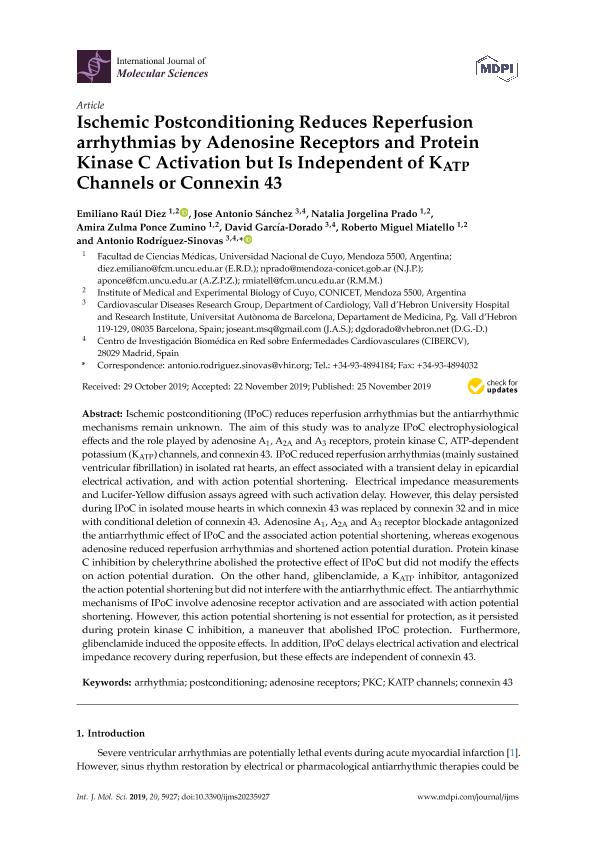Artículo
Ischemic Postconditioning Reduces Reperfusion arrhythmias by Adenosine Receptors and Protein Kinase C Activation but Is Independent of KATP Channels or Connexin 43
Diez, Emiliano Raúl ; Sánchez, Jose Antonio; Prado, Natalia Jorgelina
; Sánchez, Jose Antonio; Prado, Natalia Jorgelina ; Ponce Zumino, Amira Zulma
; Ponce Zumino, Amira Zulma ; García-Dorado, David; Miatello, Roberto Miguel
; García-Dorado, David; Miatello, Roberto Miguel ; Rodríguez-Sinovas, Antonio
; Rodríguez-Sinovas, Antonio
 ; Sánchez, Jose Antonio; Prado, Natalia Jorgelina
; Sánchez, Jose Antonio; Prado, Natalia Jorgelina ; Ponce Zumino, Amira Zulma
; Ponce Zumino, Amira Zulma ; García-Dorado, David; Miatello, Roberto Miguel
; García-Dorado, David; Miatello, Roberto Miguel ; Rodríguez-Sinovas, Antonio
; Rodríguez-Sinovas, Antonio
Fecha de publicación:
11/2019
Editorial:
Molecular Diversity Preservation International
Revista:
International Journal of Molecular Sciences
ISSN:
1422-0067
Idioma:
Inglés
Tipo de recurso:
Artículo publicado
Clasificación temática:
Resumen
Ischemic postconditioning (IPoC) reduces reperfusion arrhythmias but the antiarrhythmic mechanisms remain unknown. The aim of this study was to analyze IPoC electrophysiological effects and the role played by adenosine A1, A2A and A3 receptors, protein kinase C, ATP-dependent potassium (KATP) channels, and connexin 43. IPoC reduced reperfusion arrhythmias (mainly sustained ventricular fibrillation) in isolated rat hearts, an effect associated with a transient delay in epicardial electrical activation, and with action potential shortening. Electrical impedance measurements and Lucifer-Yellow diffusion assays agreed with such activation delay. However, this delay persisted during IPoC in isolated mouse hearts in which connexin 43 was replaced by connexin 32 and in mice with conditional deletion of connexin 43. Adenosine A1, A2A and A3 receptor blockade antagonized the antiarrhythmic effect of IPoC and the associated action potential shortening, whereas exogenous adenosine reduced reperfusion arrhythmias and shortened action potential duration. Protein kinase C inhibition by chelerythrine abolished the protective effect of IPoC but did not modify the effects on action potential duration. On the other hand, glibenclamide, a KATP inhibitor, antagonized the action potential shortening but did not interfere with the antiarrhythmic effect. The antiarrhythmic mechanisms of IPoC involve adenosine receptor activation and are associated with action potential shortening. However, this action potential shortening is not essential for protection, as it persisted during protein kinase C inhibition, a maneuver that abolished IPoC protection. Furthermore, glibenclamide induced the opposite effects. In addition, IPoC delays electrical activation and electrical impedance recovery during reperfusion, but these effects are independent of connexin 43.
Archivos asociados
Licencia
Identificadores
Colecciones
Articulos(IMBECU)
Articulos de INST. DE MEDICINA Y BIO. EXP. DE CUYO
Articulos de INST. DE MEDICINA Y BIO. EXP. DE CUYO
Citación
Diez, Emiliano Raúl; Sánchez, Jose Antonio; Prado, Natalia Jorgelina; Ponce Zumino, Amira Zulma; García-Dorado, David; et al.; Ischemic Postconditioning Reduces Reperfusion arrhythmias by Adenosine Receptors and Protein Kinase C Activation but Is Independent of KATP Channels or Connexin 43; Molecular Diversity Preservation International; International Journal of Molecular Sciences; 20; 23; 11-2019; 1-16
Compartir
Altmétricas



